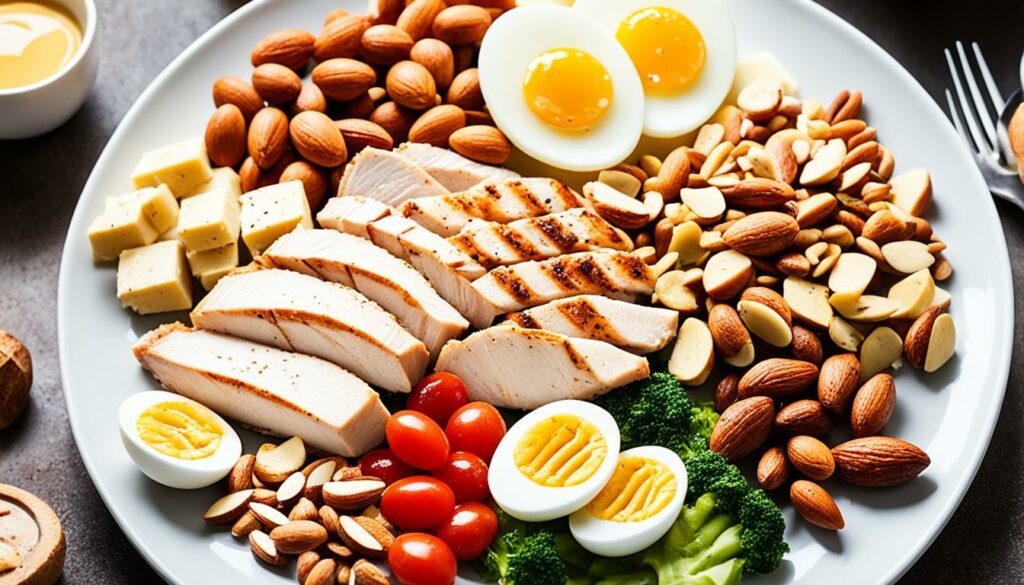Did you know that your metabolism plays a vital role in determining how many calories you burn at rest? It’s true! And here’s a surprising fact: the rate at which your body burns calories can vary significantly from person to person.
Some individuals have naturally faster metabolisms, allowing them to burn more calories even when they’re not exercising or moving around.
But don’t worry, there are evidence-based strategies you can use to boost your metabolism and increase your calorie burn. In this article, we’ll explore some top ways to increase your metabolism and maximize your calorie-burning potential.
Key Takeaways:
- Eating plenty of protein at every meal can boost your metabolism.
- Incorporating high-intensity workouts into your routine can increase your metabolic rate.
- Lifting heavy weights can help build muscle and raise your metabolism.
- Adopting healthy lifestyle habits, such as standing up more and getting enough sleep, can also have a positive impact on your metabolism.
- Remember to consult with a healthcare professional before making significant changes to your diet or exercise routine.
Eat Plenty of Protein at Every Meal
One effective way to boost your metabolism is by including plenty of metabolism boosting foods in your diet. Protein has a higher thermic effect of food compared to carbohydrates and fats, meaning that it requires more energy to be metabolized.
By incorporating protein-rich foods in every meal, you can increase your metabolic rate and support weight management.
Protein plays a crucial role in preventing muscle loss, which is commonly experienced during weight loss. When you reduce your calorie intake, your body may start breaking down muscle tissue for energy. However, consuming adequate protein can help preserve muscle mass and prevent this muscle loss.
In addition to its metabolism-boosting properties, protein also keeps you feeling fuller for longer, reducing cravings and the likelihood of overeating. This can aid in weight management and support healthy eating habits.
To ensure you’re getting enough protein, include a variety of lean sources such as chicken, turkey, fish, tofu, beans, lentils, and Greek yogurt in your meals. You can also consider incorporating protein supplements like whey protein powder or plant-based protein powder if needed.
Here’s an example of how you can incorporate protein into your meals:
| Meal | Protein Source |
|---|---|
| Breakfast | Scrambled eggs |
| Lunch | Grilled chicken breast salad |
| Snack | Greek yogurt with almonds |
| Dinner | Baked salmon with quinoa and steamed vegetables |
Remember, it’s important to consult with a healthcare professional or registered dietitian before making any significant changes to your diet or exercise routine.

Incorporate High-Intensity Workouts
To boost your metabolism and burn fat effectively, incorporating high-intensity workouts into your fitness routine is key. High-intensity interval training (HIIT) is a powerful workout technique that involves short bursts of intense exercise, followed by brief recovery periods.
During a high-intensity workout, your heart rate increases, and your body works at its maximum capacity, resulting in significant calorie burn. This type of exercise not only helps you burn calories during the workout but also continues to boost your metabolism for hours afterward.
According to studies, high-intensity workouts can increase your metabolism by stimulating the excess post-exercise oxygen consumption (EPOC) effect. This effect causes your body to continue burning calories at a higher rate even after you finish exercising.
The best part about high-intensity workouts is that they can be adapted to suit different fitness levels and preferences. Whether you prefer running, cycling, swimming, or bodyweight exercises, there are plenty of high-intensity options to choose from.
Incorporating high-intensity workouts into your routine can help you achieve a higher metabolic rate, leading to improved calorie burning and fat loss. Plus, these workouts are time-efficient, allowing you to get maximum results in a shorter amount of time.
If you’re new to high-intensity workouts, it’s essential to start gradually and listen to your body. Begin with shorter intervals and lower intensity levels, gradually increasing the intensity and duration as your fitness improves.

Benefits of High-Intensity Workouts
“High-intensity workouts are a game-changer when it comes to boosting metabolism and burning fat. These workouts not only save time but also provide significant metabolic benefits. They can help you build lean muscle mass, improve cardiovascular health, and enhance overall fitness. Incorporating high-intensity workouts into your routine is an effective way to achieve your weight loss and fitness goals.”
– Dr. Amanda Johnson, Certified Personal Trainer
If you’re looking to supercharge your metabolism and accelerate fat burning, high-intensity workouts are an excellent choice. The next section will explore the benefits of lifting heavy weights and how it can further enhance your metabolic rate.
Lift Heavy Weights
When it comes to increasing metabolism and building muscle, lifting heavy weights is key. This strength training exercise stimulates muscle growth and helps counter the drop in metabolism that often occurs during weight loss.
By incorporating heavy weightlifting into your workout routine, you can build and retain muscle, leading to a higher metabolic rate.
Strength training involves using resistance, such as free weights or weight machines, to challenge your muscles and promote growth. When you lift heavy weights, you put your muscles under significant stress, forcing them to adapt and become stronger.
Building muscle is important for increasing metabolism because muscle tissue burns more calories at rest than fat tissue. In fact, every pound of muscle can burn about 6-10 calories per day, while a pound of fat burns only 2-3 calories per day.
Incorporating compound exercises, such as squats, deadlifts, bench presses, and overhead presses, can target multiple muscle groups and maximize your muscle-building potential. Aim for 2-3 strength training sessions per week, allowing your muscles time to recover and grow between workouts.
Remember to start with weights that challenge you but still allow you to maintain proper form. Gradually increase the weight as your strength and technique improve.
By lifting heavy weights, you not only build muscle but also increase your metabolism, helping you burn more calories even at rest. Incorporating strength training into your fitness routine is crucial for achieving your muscle-building and metabolic goals.
Adopt Healthy Lifestyle Habits
Apart from diet and exercise, certain lifestyle habits can also have a significant impact on your metabolism. By incorporating these habits into your daily routine, you can help boost your metabolism naturally and support your overall health and weight management goals.
Stand Up More
Did you know that simply standing up more instead of sitting for long periods can help burn more calories? Incorporating movement breaks throughout the day, such as walking or stretching, can help increase your energy expenditure and stimulate your metabolism.
Drink Green Tea
Green tea and oolong tea contain compounds known as catechins and flavonoids, which have been found to increase fat burning and enhance metabolism. Enjoy a cup of green tea or oolong tea throughout the day to reap these potential benefits.
Eat Spicy Foods
Spicy foods, such as peppers, contain a compound called capsaicin, which can slightly boost your metabolism. Incorporating spicy ingredients into your meals can provide a small metabolic boost and add some flavor to your dishes.
Get Good Sleep
Getting a good night’s sleep is crucial for maintaining a healthy metabolism. Lack of sleep has been linked to weight gain and metabolic disturbances. Aim for 7-9 hours of quality sleep each night to support your metabolism and overall well-being.
By incorporating these healthy lifestyle habits into your daily routine, you can optimize your metabolism and support your overall health and weight management efforts. Remember, small changes can make a big difference!
| Habit | Effect on Metabolism |
|---|---|
| Standing up more | Burns more calories |
| Drinking green tea or oolong tea | Potential increase in fat burning |
| Eating spicy foods | Slightly boosts metabolism |
| Getting good sleep | Maintains a healthy metabolism |
Conclusion
Increasing your metabolism is key to achieving weight management and promoting overall health. By implementing these metabolism-boosting tips into your daily routine, you can naturally increase your metabolic rate and enhance calorie burning.
One effective strategy is to include protein-rich foods in every meal. Protein requires more energy to be metabolized, which can elevate your metabolism. Additionally, engaging in high-intensity workouts, such as HIIT, can help to further boost metabolism and burn fat.
Strength training exercises, like lifting heavy weights, are beneficial for building muscle mass and increasing metabolic rate. Don’t forget to adopt healthy lifestyle habits as well, like standing up more, drinking green tea, eating spicy foods, and getting enough sleep. These simple changes can have a positive impact on your metabolism.
However, it’s important to remember that results may vary, and it’s always wise to consult with a healthcare professional before making significant changes to your diet or exercise routine.
By taking these metabolism-boosting tips into account and incorporating them into your lifestyle, you can optimize your metabolism and support your overall well-being.
FAQ
What is metabolism?
Metabolism refers to the process in which your body converts the food you eat into energy. It is responsible for the number of calories your body burns at rest.
How can I increase my metabolism?
There are several ways to increase your metabolism naturally. These include eating plenty of protein, incorporating high-intensity workouts, lifting heavy weights, adopting healthy lifestyle habits, and consuming metabolism-boosting foods and drinks.
How does eating protein boost metabolism?
Protein requires more energy to be metabolized compared to carbohydrates and fats. By including protein in every meal, you can increase your metabolism and prevent muscle loss, which is common during weight loss.
How do high-intensity workouts boost metabolism?
High-intensity interval training (HIIT) involves quick and intense bursts of activity. This type of exercise can indirectly speed up your metabolism by increasing energy expenditure and promoting fat burning.
Why is lifting heavy weights beneficial for metabolism?
Lifting heavy weights stimulates muscle growth, which can help increase your metabolism and burn more calories at rest. This can counter the drop in metabolism that often occurs during weight loss.
What lifestyle habits can affect metabolism?
Standing up more instead of sitting for long periods, drinking green tea or oolong tea, consuming spicy foods, getting a good night’s sleep, and maintaining a balanced diet can all have a positive impact on your metabolism.
Can these strategies really increase metabolism?
Yes, incorporating these strategies can naturally boost your metabolism. However, individual results may vary, and it’s important to consult with a healthcare professional before making any significant changes to your diet or exercise routine.




